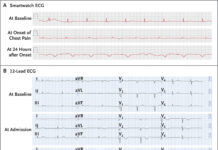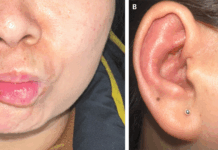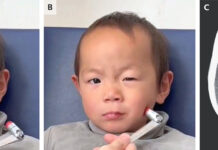A 21-month-old baby boy develops a pulsating, pruritic rash after an insect bite.
A 21-month-old baby boy presented to a pediatric emergency department with a 1-day history of a pulsating, pruritic rash on his left leg.
In the emergency department, the patient had a body temperature of 39.2°C. However, heart rate and blood pressure were normal.
Physical examination revealed a healthy baby boy who seemed well. Auscultation revealed no cardiac murmur. However, local examination of the rash on the left leg revealed an edematous and erythematous plaque. Moreover, the plaque demonstrated Quincke’s sign. In other words, it was pulsating with alternating erythema and blanching in synchrony with his pulse.
Quincke’s sign refers to the visible pulsations in the fingernail bed seen in patients with aortic regurgitation or aortic insufficiency. It is an alternating blanching and flushing of a specific site, corresponding to the arterial pulsation.
His doctors suspected the rash to be due to an insect bite. At the site of bite, the baby developed localized vasodilatation and edema. The local arterioles were unable to maintain adequate pressure during diastole, therefore, pulsating blanching and flushing phenomenon was seen.
Since the working diagnosis was of an insect bite, the doctors prescribed him an oral antihistamine called dimethindene maleate. After the first dose, within 3 hours, the pulsations stopped. Moreover, at the 3-day follow-up, the lesion had completely resolved.
References
Moran S. Gal, M. a. (2021, January 28). A Pulsating Leg. Retrieved from The New England Journal Of Medicine: https://www.nejm.org/doi/full/10.1056/NEJMicm2022429




